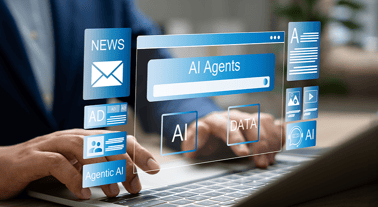If you caught our last blog, "Enterprise AI Done Right: A Practical, People-First Guide," you know we’re all about making AI work for people—employees, customers, and stakeholders—not just for the sake of tech itself. Since then, I’ve considered what’s next for enterprise AI, especially with Global Capability Centers (GCCs) becoming important and emerging agent-to-agent AI trends. So, let’s talk about how these pieces fit together and what the future might look like— it’s exciting, and it’s still all about the humans.
GCCs: The Catalysts for Global Innovation
First, let’s talk GCCs. If you’re unfamiliar, these are hubs—often offshore—where companies centralize key functions like IT, analytics, or customer support. Envision them as the energetic powerhouses of modern business, full of energy and creativity in the lively metropolises of Hyderabad, Noida, Bangalore, Manila, and Warsaw. Over the years, GCCs have evolved from cost-saving back offices into innovation powerhouses, and now they’re at the heart of AI adoption.
Why? Because GCCs bring together talent, tech, and process expertise at scale. They’re already helping global firms roll out AI—think chatbots for customer service or predictive models for supply chains. But here’s where it gets interesting: GCCs aren’t just implementing it as AI gets smarter—they’re shaping it. And with agent-to-agent AI entering the scene, their role is about to level up.
Agent-to-Agent AI: Teamwork, AI-Style
What is agent-to-agent AI? Imagine a couple of AI systems—let’s call them agents—working together like a dream team. One agent digs into customer data, another tweaks inventory, and a third predicts demand, all chatting in real time. No human micromanaging, just smooth coordination. It's like having a team of super-smart assistants who boost productivity and efficiency around the clock.
This isn't some far-off dream—it's like rocket science becoming routine. What once seemed complex is now within your reach and happening right now. In a GCC setting, picture this: one agent in Manila flags a spike in customer complaints, another in Hyderabad crunches the data to find the root cause, and a third in Bangalore adjusts the support workflow—all without a dozen emails flying around. It’s fast, efficient, and frees people to focus on the big-picture stuff.
The Future: GCCs + Agent-to-Agent AI
So, where are GCCs and AI heading together? I see a future where GCCs become the nerve centers for agent-to-agent AI, driving innovation and keeping enterprises agile. Here’s how it might play out:
- Smarter Operations: GCCs could deploy agent networks to handle end-to-end procurement or claims processing across time zones. One agent spots a delay in Shanghai, another reroutes supplies from Mumbai, and the team barely notices the hiccup.
- Human-AI Harmony: With agents taking on the routine and repetitive work, GCC staff shift to higher-value roles—strategizing, innovating, or building relationships. It’s less about replacing jobs and more about upgrading them.
- Global Insights, Local Impact: GCCs, with their diverse talent pools, can fine-tune agent-to-agent systems to reflect regional needs— for example, customizing customer responses for APAC versus EMEA—all while sharing best practices globally.
The numbers back this up, too. Analysts say GCCs could contribute over $500 billion to the global economy by 2030, with AI as a key driver. Add agent-to-agent AI, and you’ve got a recipe for transformative impact.
Doing It Right: People First, Always
Technology will work only if we keep people in the driver’s seat. So, how do we make it happen?
- Build Trust: Show teams in the GCC what the agents are doing—maybe with a simple dashboard. If they see how it saves them time, they’ll embrace it.
- Focus on Outcomes: Don’t just automate for efficiency’s sake. Use agents to cut stress, like reducing ticket backlogs, or delight customers with faster fixes.
- Train Up: Give GCC teams quick, hands-on sessions to work with these agents. It’s not about coding but knowing how to nudge the system when needed.
- Keep It Simple: Set up checks so agent decisions don’t accidentally amplify biases, like favoring one region’s data over another. Humans need to stay in the loop.
A Quick Game Plan
- Start Small: Find a process in your GCC that could use some agent teamwork.
- Set Up the Crew: Use tools like Azure AI to link two or three agents. Test it in a safe space first.
- Watch and Learn: Prototype and track how it helps (e.g., faster orders, happier staff), and modify as you go.
- Scale It: Expand to other GCC functions - maybe finance or HR.
It’s less about speed and more about getting it right for your team.
Conclusion: A Cooperative Future
The future of enterprise AI isn’t just about smarter technology - it’s about GCCs and agent-to-agent AI teaming up to make work better for everyone. It’s a chance to blend global scale with human touch, which excites me. At Coforge, we’re already helping clients explore this space, and the results are promising.
Curious about what agent-to-agent AI and GCCs can do for you?
Explore our GCC capabilities and see the future in action.




